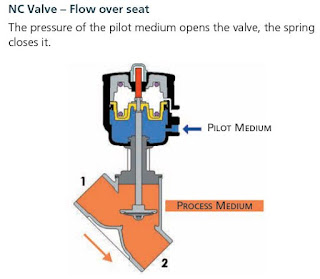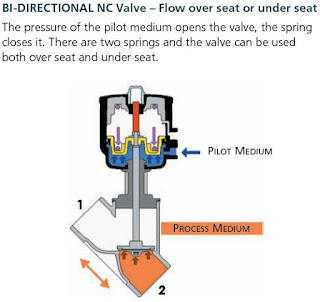Piston Valve Applications: Manufacturing Paraffin Wax
M&M Piston actuated valves can be used in a wide variety of applications, in this blog post we are going to provide some examples of Piston Valves used in Manufacturing Paraffin Wax and the type of valve that we would recommend for this application.
Piston actuated valves used in manufacturing paraffin wax:
You can view the V-Flow Solutions range of M&M Piston actuated valves here:
Piston actuated valves used in manufacturing paraffin wax:
Extrusion machines and presses are used in the
industrial production of candles.
These machines
work with paraffin wax powder.
The equipment used for
manufacturing paraffin wax powder consists of a leakage tank, a sprinkling unit
and a pulverizing roller.
The leakage tank is loaded with solid paraffin wax,
which is warmed up to the melting temperature by a coil heat exchanger.
Valve
(A) controls diathermic oil at 140° at the pressure of 3 bar and lets it into
the tank coil.
Liquefied paraffin is pumped into a warmed duct and
sprinkled onto the cooling roller through special nozzles.
The sprinkling duct
is warmed by diathermic oil controlled by valve (B).
Cooled paraffin is scraped off the surface of the
roller and collected in vibrating ducts.
The diameter of the cooling roller varies according to
the quantity of paraffin to be obtained.
Paraffin wax powder is then loaded into the moulds where it is pressed
into various shapes to get the finished candles.
The valve that we would recommend for this application is:
You can view the V-Flow Solutions range of M&M Piston actuated valves here:
V-Flow Solutions: Piston Valves
You can read the rest of V-Flows blogs here.
M&M Angle seat piston valves
M&M piston valves are highly recommended under these conditions:
Technical Information
You can read the rest of V-Flows blogs here.
M&M Angle seat piston valves
M&M piston valves are manufactured in Italy, using the highest quality materials for a high quality product.
M&M piston actuated valves use an external control media to pilot the actuator, where a piston valve is directly connected to the main seal that closes onto the main orifice, thereby controlling the flow of liquids and gases.
- Media containing dirt particles
- Highly viscous media (up to 600 cST (80°E); 1 centistoke = 1 mm2/s)
- High flow volumes
- High temperatures
- Damp environments or hazardous locations
|
|
|
|
|
Technical Information
The main seal material used in piston actuated valves:
A modified PTFE has been used as the main seal material since 2004, when it replaced the original PTFE material seal.
The modified PTFE seal provides these benefits over the previous verision:
- Lower porosity and permeability
- Fewer void spaces
- Higher elasticity
- Reduced deformation under load
- Better chemical resistance to controlled media
- Smoother surface and improved design flexibility
The standard bonnet seals consist of 2 'V'-shaped FKM gaskets and a package of 25% graphite-filled PTFE gaskets.
High temperature Piston actuated valves:
M&M can offer a piston valve that can be used up to 200°C, provided that the valve pressure limits are respected.
The main differences, in regards to the materials in this design, are as follows:
The main differences, in regards to the materials in this design, are as follows:
- Change of the actuator material: From standard PA6 to PA66 filled with 30% fibreglass
- All valves with DN > 25 with fixed plug design (to withstand turbulence caused by steam at high speed)
- Special design of bonnet chevrons, all are made of 25% graphite-filled PTFE
10 Reasons to use a piston actuated valve:










Comments
Post a Comment